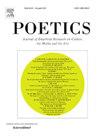教授-作家和机械师-画家-摄影师:职业类别和艺术爱好之间的二元性的调查
IF 1.7
2区 社会学
0 LITERATURE
引用次数: 0
摘要
尽管自二十世纪初以来,就业人员对艺术(又称业余爱好)的参与稳步上升,但相关研究并未系统地探讨职业与业余爱好之间的关系。为了填补这一空白,我们借鉴布雷格在二元性方面颇具影响力的研究成果,对这两种参与形式的交集和文化共构进行了研究。我们引入了一种名为 "关联规则 "的机器学习方法,利用 "公众艺术参与调查 "的数据生成了一个由职业和爱好组成的双模式网络。我们的分析表明,这两个建构之间的关系与文化全能模型并不一致。相反,这两个构念的属性(如时间性和合作程度)决定了它们之间的关联,并对其文化意义产生了影响。陶艺和绘画通常是独乐乐不如众乐乐的爱好,它们与大多数职业都有关联,但却是性别化 男性、工作时间自主性较低的蓝领职业的专属领域。另一方面,需要投入大量精力的合作性音乐嗜好则只与自主性较强的职业有关。编织和写作这些以 "清醒 "著称的便携式爱好,则与白领和蓝领的静态工作有关。业余爱好的共享性及其文化意义的差异性,对侵蚀和维持职业群体之间的文化和社会距离具有影响。同样,合作程度对爱好群体内部的联系以及职业群体在当地社区的可见度和嵌入度也有影响。本文章由计算机程序翻译,如有差异,请以英文原文为准。
Professor-writers and machinist-painter-photographers: Investigating the duality between occupational categories and artistic hobbies
Even though participation in the arts (a.k.a. hobbies) of employed persons has risen steadily since the early twentieth century, research has not systematically explored the relationship between occupations and hobbies. We address this gap by investigating the intersection and cultural co-constitution of these two forms of engagement by drawing on Breiger's influential work on duality. We introduce a machine-learning approach called association-rules to generate a two-mode network comprising occupations and hobbies using data from the Survey of Public Participation in the Arts. Our analysis shows that the relationship between the two constructs is not consistent with the cultural omnivorousness model. Instead, attributes of the two constructs like temporality and degree of collaborativeness shape their association with implications for their cultural significance. Pottery and painting, generally solo hobbies, are associated with most professions, but are the exclusive domain of gendered male, blue-collar occupations that have less autonomy on working hours. Collaborative music hobbies, entailing considerable commitment, on the other hand, are exclusively associated with occupations with such autonomy. Weaving and writing, portable hobbies that have a reputation of being ‘woke,’ are connected to white- and blue-collar sedentary jobs. Sharedness of hobbies and variability in their cultural significance have implications for the erosion and maintenance of cultural and social distance between occupational groups. Degree of collaborativeness, likewise, has implications for connectedness within hobby groups as well as visibility and embeddedness of occupational groups in local communities.
求助全文
通过发布文献求助,成功后即可免费获取论文全文。
去求助
来源期刊

Poetics
Multiple-
CiteScore
4.00
自引率
16.00%
发文量
77
期刊介绍:
Poetics is an interdisciplinary journal of theoretical and empirical research on culture, the media and the arts. Particularly welcome are papers that make an original contribution to the major disciplines - sociology, psychology, media and communication studies, and economics - within which promising lines of research on culture, media and the arts have been developed.
 求助内容:
求助内容: 应助结果提醒方式:
应助结果提醒方式:


